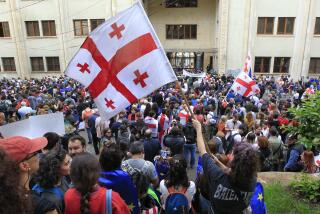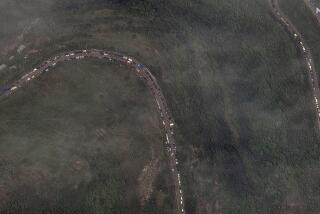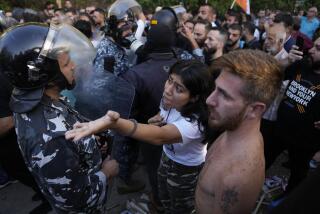A Huge Country, Huge Mix of People
- Share via
Soviet Union’s 287 million people consist of more than 100 officially recognized ethnic or national groups living in 15 union republics, 20 autonomous republics, eight autonomous regions and 10 autonomous areas. The Russian Federation, with about 148 million people and 76% of the land, is largest. About 60 million Soviets live outside their “home” republics, including 25 million Russians, partly because of policies to “Russify” parts of the Baltics, Ukraine and Kazakhstan. Nearly 20% of Russia’s population is non-Russian, divided among 38 national minorities.
CENTRAL ASIA
Five Central Asian republics are Kazakhstan, Kirghizia, Tadzhikistan, Turkmenistan and Uzbekistan. So far, only Uzbekistan is moving toward independence.
History: Populated by semi-nomads, with urban populations centered in trading towns such as Tashkent and Samarkand, region has long been target of Russian expansion. Czars gained control of Kazakhstan in 1731. Rest of region fell under Moscow’s grip in 19th Century and 1920s.
People: About 50 million people, mostly Muslim, and experiencing rapid growth.
Prospects: Region has major natural resources--coal, oil, natural gas, ores--and rich agricultural regions specializing in crops such as wheat and cotton. Any move toward economic independence would be arduous. Under Soviet rule, region’s natural resources have gone to feed factories in Russian industrial heartland. Asian republics would be handicapped by poverty, poor transportation, low education and rapid population growth. Moscow will be reluctant to lose control of Kazakhstan, where Russians come close to outnumbering Kazakhs. Territory includes main Soviet space center at Leninsk and Semipalatinsk underground nuclear test site.
BALTICS
Lithuania, Latvia and Estonia have declared independence and are being recognized by nations around the world.
History: Lithuania has a long history of independence. In 13th and 14th centuries, it was a major regional power whose control extended as far south as Kiev. Latvia and Estonia were dominated by feudal German lords, Danes and Swedes. Estonia and Latvia fell to Peter the Great in 1709. Lithuania became part of Russian Empire under Catherine the Great in 1795. All three Baltic states claimed independence in 1918. All fell back under Moscow’s rule as a result of Aug. 23, 1939, secret treaty between Adolf Hitler and Josef Stalin.
People: With a total of 8 million people, Baltics make up slightly more than 2.5% of Soviet population. Lithuania’s 3.7 million people are mainly Lithuanian, with 9% Russians and 11% Byelorussians, Poles and remnants of one of Eastern Europe’s largest Jewish communities. Populations of Latvia and Estonia are roughly one-third Russian. Latvians and Lithuanians are closely related and ancestry is similar to that of surrounding Slavs. Estonians are more closely related to Finns. Lithuanians are primarily Roman Catholic. Latvians and Estonians are primarily Lutheran as a result of centuries of German rule.
Prospects: Baltics’ standard of living is higher than rest of Soviet Union but still low compared with Europe. They produce much of Soviet Union’s appliances--from TV and radio equipment to washing machines and refrigerators. But they must import most raw materials, including energy supplies. Region’s factories are geared to Soviet standards and would require major upgrade before they could sell in world market. Latvian ports, usable year round, serve as headquarters for Soviet Atlantic fishing fleet. Lithuania has major agricultural base, especially dairy and livestock.
WESTERN FRONTIER
Byelorussia, Moldova and Ukraine have all declared independence.
History: Byelorussia and Ukraine are long linked with Russia. First Russian state was ruled from Kiev, now Ukraine’s capital. Byelorussia has never been independent. Ukraine was a self-governing entity under Don Cossacks during parts of 17th Century but quickly came under czarist rule. Moldova was governed by a kaleidoscope of rulers. Before Soviet rule, much of its land was part of Romania.
Population: Ukraine is second-most populous republic in Soviet Union, with 52 million people. Byelorussia has 10 million people. Without them, Soviet population would be tilted far more heavily toward Central Asian Muslims. Moldova’s 4.3 million people are related to Romanians and there is a large Russian minority.
Prospects: If Moldova becomes independent, there is speculation of possible merger with Romania. Ukraine produces much of Soviet food and large parts of its industry. But agriculture and industry face same problems Russia does in converting to free market. Russia likely to try to retain control of rich industrial areas of eastern Ukraine, heavily populated by Russians. Byelorussia has agricultural economy, with large production of forest products. Its declaration of independence is seen as attempt by hard-line Communist leaders to escape reform wave emanating from Moscow.
CAUCASUS
Georgia has declared independence. Armenia plans independence vote in September. Azerbaijan so far has not moved for independence.
History: Armenians and Georgians have histories stretching more than 2,500 years with long periods of foreign domination. Both peoples often sought protective alliances with Russians. Moscow annexed Georgia in 1801. Armenians once occupied huge areas of what is now Turkey but about 1.5 million were killed there in 1915. Soviet Union and Turkey divided Armenian territory in 1920. Azerbaijan was part of Persian Empire until conquered by czarist armies in 19th Century.
People: Georgians and Armenians converted to Christianity in 4th Century, living in enclaves surrounded by non-Christians. The 3.3 million Armenian residents are fairly homogeneous. The 5.7 million residents of Georgia include large numbers of non-Georgians. Azerbaijan’s 7 million population is mostly Muslim and Turkish speaking. Its Nagorno-Karabakh autonomous region, which is 76% Armenian, has provoked ethnic strife.
Prospects: They face a mix of optimistic economic forecasts and potentially devastating civil strife. Georgia is chief Soviet producer of citrus crops, tea, tobacco and wine. It has large oil fields and refineries, a big metallurgical industry and ports on Black Sea. Azerbaijan has large oil reserves and a major port at Baku on Caspian Sea. Armenia has well-developed agriculture and industry. But vicious fighting between Armenians and Azerbaijanis over last 3 1/2 years could be only a portent for the future, given region’s bloody history and volatile ethnic and religious mix.
More to Read
Sign up for Essential California
The most important California stories and recommendations in your inbox every morning.
You may occasionally receive promotional content from the Los Angeles Times.













